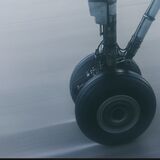Why do planes take off down the centre line?
Discussion
I feel I'm setting myself up to look stupid here but having watched a lot of cockpit videos on YouTube something that's always puzzled me is why takeoff seems to be exactly down the centre line so it looks from the cockpit vids like the airplane is getting quite a shaking from the front gear going over all the centre lights.
Seems a bit like deliberately driving down a row of cats eyes at high speed and the accompanying bumps unless the videos are exaggerating the effect?
Seems a bit like deliberately driving down a row of cats eyes at high speed and the accompanying bumps unless the videos are exaggerating the effect?
If your directional control is impacted by (as said above) wind, “contamination” on the runway, or an engine failure on a twin (or other thrust asymmetry), you’ll benefit from having as much room as possible to sort it out before running off the edge.
Some airports like Mykonos have narrower runways than the fairly standard 45 metres, so flying there requires extra training to be completed.
Some airports like Mykonos have narrower runways than the fairly standard 45 metres, so flying there requires extra training to be completed.
surveyor said:
We put them in the centre.The centreline lights are actually used as a form of braille for the few blind pilots on a diversity hire, so when the "bumps" get closer together the pilot knows to lift the nose and take-off. Landing was a whole lot trickier until they allowed guide dogs to be used, now the pilot can just feel when the lead goes slack to know they're close to the ground.
True story.

True story.

IanH755 said:
The centreline lights are actually used as a form of braille for the few blind pilots on a diversity hire, so when the "bumps" get closer together the pilot knows to lift the nose and take-off. Landing was a whole lot trickier until they allowed guide dogs to be used, now the pilot can just feel when the lead goes slack to know they're close to the ground.
True story.

Have a True story.





Reminds me of that old joke about the blind parachutist...
Going over the lights doesn’t cause them or the plane any harm, nor any discomfort to passengers (other than an already abrupt/loud part of the journey). So it makes perfect sense to train pilots to position the aircraft right down the middle.
If pilots were taught to align the aircraft “just to the side of the centreline” it would then create a grey area e.g “how far can I stray from the middle?” As other posters have said above, straying from the middle is not ideal for many reasons.
As such, the centreline serves the best point for pilots to align with.
If pilots were taught to align the aircraft “just to the side of the centreline” it would then create a grey area e.g “how far can I stray from the middle?” As other posters have said above, straying from the middle is not ideal for many reasons.
As such, the centreline serves the best point for pilots to align with.
Thanks all.
Honestly when you watch some of the videos the sound of the bumps seems very audible to the point where if it was a car you'd try not to go over them.
If it's as simple as other than sounding a bit noisy they don't do any damage that's fair enough and perhaps I was overthinking it
Honestly when you watch some of the videos the sound of the bumps seems very audible to the point where if it was a car you'd try not to go over them.
If it's as simple as other than sounding a bit noisy they don't do any damage that's fair enough and perhaps I was overthinking it

Gassing Station | Boats, Planes & Trains | Top of Page | What's New | My Stuff







